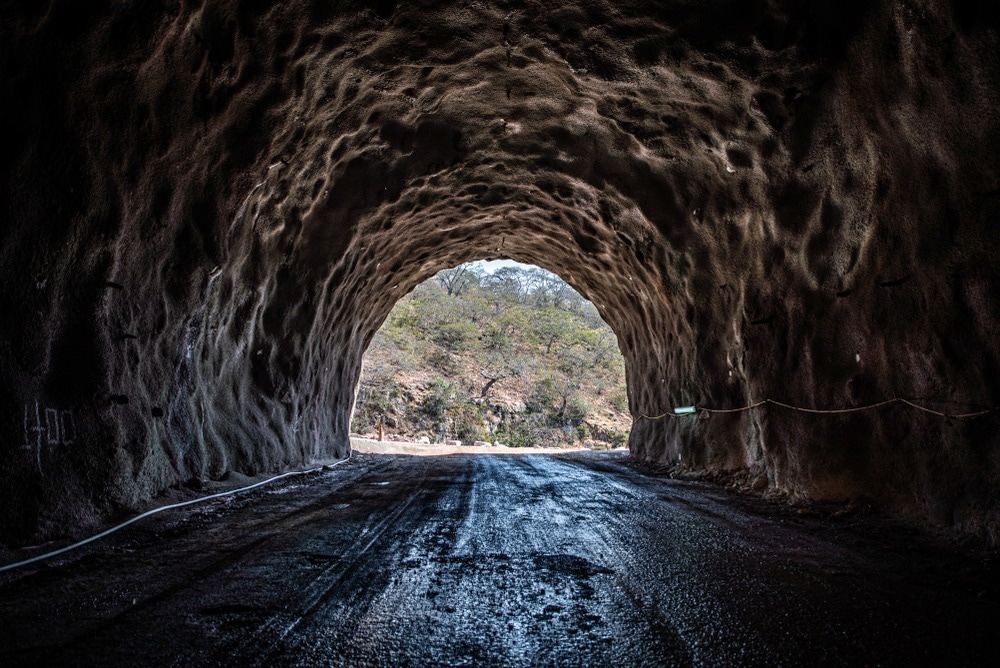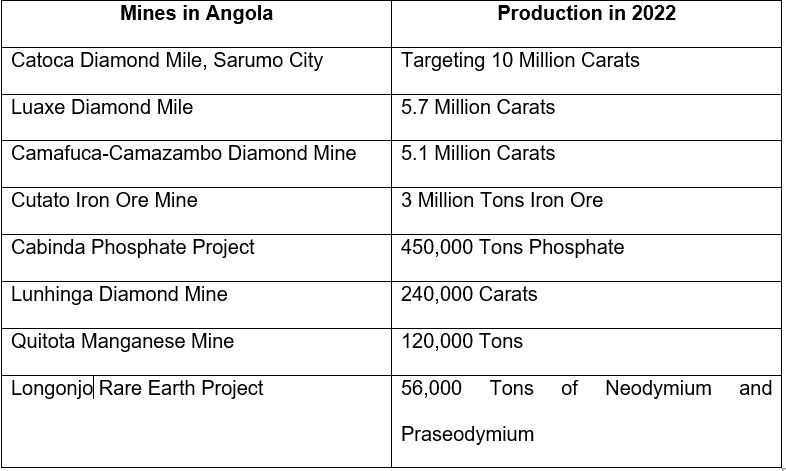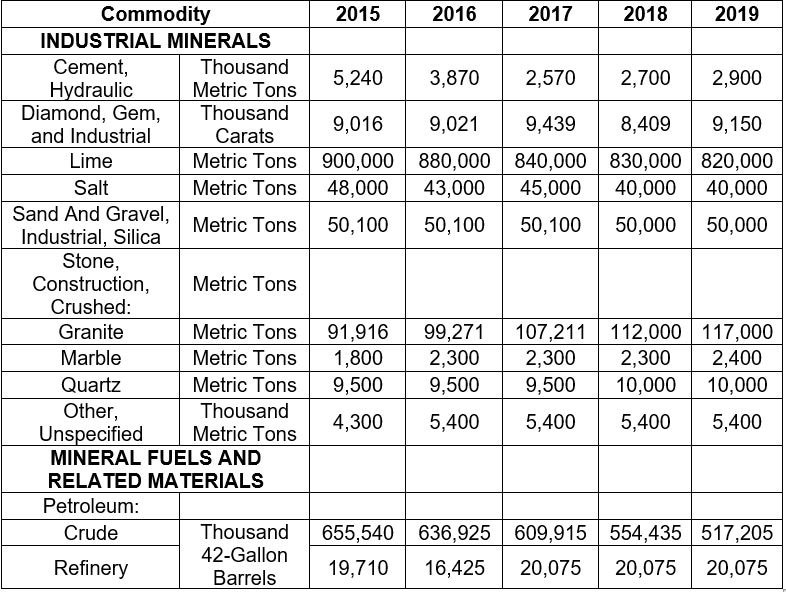The Republic of Angola, situated in the western part of Southern Africa, is the second-largest country south of the Sahara, following the Democratic Republic of Congo. As per the latest information provided by the World Bank, in 2022, the population of Angola was more than 33.08 million. The area of the country spans 1,247,000 km2. Angola possesses considerable mineral and oil resources, driving robust economic growth.

Underground excavation in Angola, Africa. Image Credit: Antonio Rodrigues Peyneau/Shutterstock.com
A Brief Overview of Angola’s Economy
Angola's economic growth relies heavily on the global oil demand, resulting in fluctuating growth. The government of Angola has made several laws to encourage more private-sector involvement, particularly in the financial sector.
In 2022, the growth rate of Angola’s economy increased to 3% compared to 1.2% in 2021. This was possible due to the expansion in non-oil sectors and a modest recovery in oil production. The rise in oil prices facilitated fiscal expansion, particularly in public investments, leading to an appreciation of the domestic currency. These steps increased the general public's confidence, confirmed by a 7% boost in private consumption.
The improvement in the economy is due to a 0.5% growth in the oil sector. The oil sector peaked in 2010; after 2015, it was the first time an improvement was observed. A 0.3% year-on-year expansion has been recorded by the experts in 2023. The Angolan services market recorded a growth of 4.1% in 2023. However, the experts observed an 8% reduction in oil production.
The Central Bank has maintained the reference rate at 17% in response to rising inflationary pressures. The 2023 growth projection is around 1.3%, with expectations of underperformance in the oil and non-oil sectors. Despite a recent uptick in oil production, the average for 2023 is anticipated to be similar to the 2022 level.
Development in Angola’s Mining Industry
The mining of diamonds is a major revenue-generating resource of Angola. Angola is the fourth-largest diamond producer globally, generating approximately 9.3 million carats in 2021. However, a significant portion of its interior regions remains unexplored.
As per the African Diamond Council, the official regulatory body for the African diamond sector, Angola's diamond industry contributed nearly €1.2 billion to annual production in 2021, serving as one of the country's primary revenue sources.
Angola stood out globally as the only country experiencing production growth, which was attributed to recent discoveries of diamond deposits. The Luaxe and Catoca mines emerged as the third and fourth largest diamond explorations worldwide. In 2021, the Angolan government reported the sale of approximately 8.9 million carats of diamonds, marking a 15.6% increase from the 7.7 million sold in 2020.
Since 2013, in addition to the oil industry and diamond mining, the exploration of other minerals has gained prominence in Angola's mining sector. Copper, platinum, gold, and iron ore are considered 21st century minerals. With considerable known reserves in Angola, these minerals are crucial to the country's national development plan.
After 2020, 28 gold mining projects have been licensed by the government, with 20 currently in the exploration phase. An example of such a project is the Buco-Zau mine in the northern province of Cabinda, which, within six months, yielded 15 kg of gold from a secondary deposit.
A summary of the production of mines in Angola is as follows:
Table: Energy Capital Power Available at: https://energycapitalpower.com/biggest-mines-in-angola-by-production/

Mineral Production in Angola
The United States Geological Survey published a report detailing the production of a few specific minerals in Angola from 2015 to 2019.
Table: Production of mineral commodities in Angola: Report by U.S. Geological Survey Source: https://pubs.usgs.gov/myb/vol3/2019/myb3-2019-angola.pdf

Oil and Gas Resources in Angola
The International Trade Administration published a comprehensive report on Angola's oil and gas resources in 2022. The report highlights that the Angolan land has oil and gas resources that have not been discovered. An expert survey in 2022 confirmed that Angola contains 9 billion barrels of proven crude oil reserves and around 11 trillion cubic feet of natural gas reserves, which are yet to be refined for utilization.
Experts from the United States monitored oil production in Angola. The initial study in 2022 revealed that the daily oil production in Angola was 1.16 million barrels of oil per day (bpd). In the peak oil production year of 2010, oil production was 2 million bpd.
The mining of diamonds and the oil sector are Angola's major revenue generators. The petroleum industry accounts for around 75% of Angola's total revenue. The natural gas extraction industry supports it well. The volume of natural gas production in Angola is around 17.9 billion cubic feet, making it the backbone of the Angolan economy.
Forecast and Major Players
The report states that until 2027, Angola's oil and gas market is expected to grow more than 1.5%. However, certain challenges, such as underdeveloped infrastructure and excessive costs, restrict the international and national companies and make it quite demanding for such corporations to invest.
Key international players in oil exploration and production in Angola include Total, holding a 41 percent market share, Chevron with 26 percent, Exxon Mobil with 19 percent, and BP with 13 percent. Other participants include ENI and Equinor. Sonangol, through its subsidiary Sonangol E&P, is also active in the sector.
Angola contains a wealth of mineral resources. The government of Angola is focusing on sustainability and green energy production and attracting international companies for efficient and safe mineral extraction.
References and Further Reading
Chambers and Partners, (2023). Mining 2023 Angola. [Online] Available at: https://practiceguides.chambers.com/practice-guides/mining-2023/angola/trends-and-developments [Accessed 8 November 2023].
Energy Capital & Power, (2022). Biggest Mines in Angola by Production. [Online] Available at: https://energycapitalpower.com/biggest-mines-in-angola-by-production/ [Accessed 9 November 2023].
Mining Technology, (2023). Diamond production in Angola and major projects. [Online] Available at: https://www.mining-technology.com/data-insights/diamond-in-angola/?cf-view [Accessed 8 November 2023].
The World Bank, (2023). The World Bank in Angola. [Online] Available at: https://www.worldbank.org/en/country/angola/overview#3 [Accessed 7 November 2023].
U.S. Geological Survey, (2019). 2019 Minerals Yearbook: Angola. [Online] Available at: https://pubs.usgs.gov/myb/vol3/2019/myb3-2019-angola.pdf [Accessed 10 November 2023].
United States Department of Commerce, (2022). Oil and Gas-Angola. [Online] Available at: https://www.trade.gov/country-commercial-guides/angola-oil-and-gas [Accessed 10 November 2023].
Vitor, M. & Da Costa, J., (2022). A new era in the Angolan mining landscape: the consequences of the recent split of the Angolan mining national concessionaire. [Online] Available at: https://www.ibanet.org/new-era-angolan-mining [Accessed 8 November 2023].
Disclaimer: The views expressed here are those of the author expressed in their private capacity and do not necessarily represent the views of AZoM.com Limited T/A AZoNetwork the owner and operator of this website. This disclaimer forms part of the Terms and conditions of use of this website.